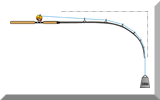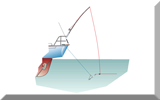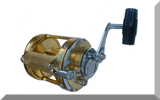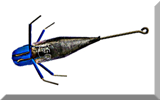- Home
- Fishing Rigs
- Stinger Rig
Use the Stinger Rig to Hook Short-Striking Fish
The stinger rig is less well known than the other two-hook rig - the pennel rig - but they're both designed to deal with short-striking fish. It happens like this...
In a typically unsporting manner, fish sometimes attack our lures and baited hooks with less than total commitment.
The result is that they fail to properly engulf the hook, often succeeding in stealing the bait and getting away with it scot-free.
The solution to this rather unreasonable behaviour is to place a second hook very close to the end of the bait - the bit where a wary (but unlucky) fish might take an exploratory nibble at.
Pennel or Stinger Rig?
What the Pennel Rig has going for it is its flexibility in as much as its overall length can be adjusted by moving the first hook up and down the line.
It's ideal for use on long baits like marine worms and large baits like squid and sprats - providing the two hooks don't slide closer together. If they do, the bait will be bent into a 'U' shape and is likely to spin, killing it if it was alive and in any event making it much less appealing to any interested fish.
Bottom line? Don't use the Pennel Rig in strong tides or with a particularly energetic livebait. Read more about the Pennel Rig here...
Solution? The Stinger Rig...
One version of it is nothing more than a second hook, often - but not always - a treble hook as shown here, attached to the primary hook by a short length of line.
It can be lightly hooked under the skin of the bait, or left loose to stream alongside.
If the primary hook trace is of single-strand wire to avoid being bitten through, then the stinger trace should also be made up in single-strand wire using haywire twist connections, or in plastic covered multi-strand wire connected with crimped sleeves. Otherwise, use mono line and uni-knots.
Whatever line material you use, the stinger hook will now be taking the full load of the fish, so it must be securely attached to the eye of the primary hook using the appropriate form of connection.
An alternative form avoids the use of the single-strand wire and the two attendant haywire twists altogether.
How? Well, just by threading the eye of a second hook over the point of the primary hook so that it trails from the bend of the primary hook.
If this still doesn't get the stinger hook far enough aft, daisy chain a third hook on the bend of the second.
There's nothing very complicated about this rig, but when the fish are short-striking your bait or lure, it can make all the difference.
Recent Articles
-
Sea Fishing Rods and Reels Must Be Compatible for a Balanced Outfit
Mar 08, 21 08:30 AM
A quality reel fitted to a quality rod doesn't necessarily make it a quality outfit. Your fishing rods and reels have to be properly matched if you're to get the best out of them, and here’s how -
Essential Lure Fishing Tips That All Saltwater Anglers Should Know
Mar 08, 21 04:51 AM
Which single lure fishing tip applies to trolling, jigging, baitcasting, spinning, fly fishing and any other branch of lure fishing? Well, it is the one at the top of this list -
Vital Jig Fishing Tips That You Really Cannot Afford To Miss!
Mar 07, 21 10:20 AM
Essential jig fishing tips to help you select the right lure for successful jig fishing, together with the techniques required to get the most out of your jig fishing outfit


























New! Comments
Have your say about what you've just read! Leave me a comment in the box below.